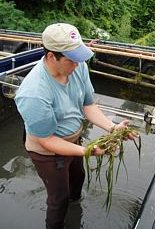Narragansett Bay Estuary Program (RI) Partners to Secure Grants to Protect the Watershed
Forming partnerships are often crucial to successful grant applications. Combining forces and committing to collaboration (and sharing credit!) make for more attractive funding proposals and a stronger voice for watershed protection and restoration. In this example, the Pew Charitable Trusts funded a proposal submitted by Save The Bay, a 501(c)(3).
Save The Bay strengthened its application by demonstrating a strong partnership with the Narragansett Bay Estuary Program (NBEP), a university-based watershed restoration effort. In turn, Narragansett Bay used their partnership with Save The Bay to leverage additional state and federal grant funds.
In 1996, Save The Bay and NBEP embarked on a series of projects to construct an inventory of the state's coastal habitats. This effort included bringing the data into GIS mapping systems. Both partners took advantage of their organizational structure and staff skills to secure funding and implement habitat restoration projects.

Save The Bay successfully applied to the Pew Charitable Trust for grant funding that was available to partners in the Restore America’s Estuaries coalition. Pew Charitable Trusts contributed $200,000 to support habitat assessment and restoration projects in Narragansett Bay undertaken by Save The Bay and NBEP. The two groups used the foundation money as match for state and federal grants, which provided an additional $400,000 for Narragansett Bay habitat restoration efforts.
- map critical eelgrass beds, salt marsh habitat areas and coastal features
- hire technical staff to identify potential restoration sites and develop restoration plans
- launch an extensive public information campaign
This collaboration also helped form the Rhode Island Habitat Restoration Team. The team is an ad hoc, but highly effective, partnership that has shaped goals, identified projects and attracted additional funding for coastal habitat restoration. Moreover, their efforts include the creation of a dedicated state fund for restoration projects.
For more information, please visit Narragansett Bay Estuary Program .
This eelgrass mariculture facility was constructed in 2004 with EPA Targeted Watershed Initiative grant funds. It is one of the results of a partnership effort between NBEP, University of Rhode Island Graduate School of Oceanography and Save The Bay to restore critical bay habitat.
